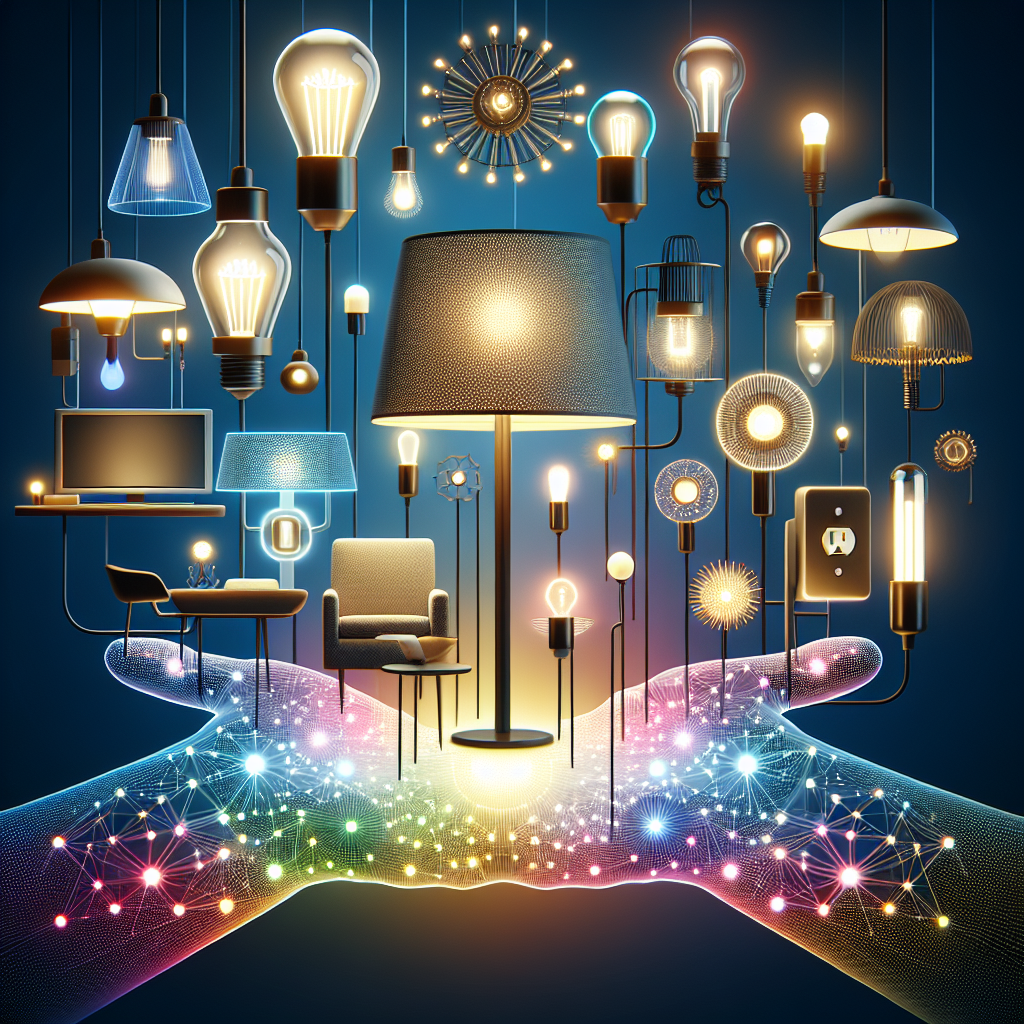Are you ready to transform your space with the latest lighting trends that are set to take the world by storm in 2023? From eye-catching geometric fixtures to futuristic holographic projections, this article explores the innovative lighting designs that will revolutionize the way we illuminate our homes and commercial environments. Get ready to say goodbye to ordinary lighting and hello to a world of mesmerizing, functional, and visually stunning illumination that will truly elevate your space to new heights. Get ready to be inspired as we explore the top lighting trends you need to watch out for in the coming year.

Smart Lighting
In today’s fast-paced world, technology has made its way into every aspect of our lives, including lighting. Smart lighting is revolutionizing the way we illuminate our spaces, offering convenience, efficiency, and a touch of futuristic sophistication.
Voice Control
Imagine being able to control your lights with just the sound of your voice. With voice control technology, this is now a reality. Smart lighting systems are compatible with voice assistants like Amazon Alexa and Google Assistant, allowing you to effortlessly turn on/off lights, adjust brightness, and even change colors, all without lifting a finger. Gone are the days of fumbling for switches; all you need to do is speak up and let your smart lighting system do the rest.
Artificial Intelligence
Smart lighting goes beyond simple voice commands; it can learn and adapt to your preferences over time. Thanks to artificial intelligence (AI), your lights can anticipate your needs and adjust accordingly. For example, if you tend to dim the lights in the evenings, the AI-powered system will automatically create personalized lighting scenes without you having to lift a finger. This level of customization and convenience enhances not only your lighting experience but also your overall comfort and well-being.
IoT Integration
The Internet of Things (IoT) has taken the world by storm, and smart lighting is no exception. By integrating your smart lighting system with other IoT devices, you can create a seamlessly connected and automated home or workspace. For instance, imagine walking into a room, and the lights automatically turn on, the blinds open, and your favorite playlist starts playing on the speakers. IoT integration allows for a harmonious and effortless user experience, transforming your space into a smart and intelligent environment.
Human-Centric Lighting
Human-centric lighting focuses on the impact of light on our well-being and productivity. By mimicking natural lighting conditions, this innovative trend aims to optimize our circadian rhythms and create a healthier and more comfortable living and working environment.
Circadian Rhythm
The circadian rhythm is our body’s internal clock that regulates our sleep-wake cycle and various bodily functions. Human-centric lighting takes into account the natural progression of daylight throughout the day, adjusting the color and intensity of artificial light to support our circadian rhythm. This synchronization can improve our sleep quality, enhance our mood, and increase our productivity, creating a holistic and harmonious atmosphere.
Biodynamic Lighting
Biodynamic lighting takes the concept of circadian rhythm a step further by incorporating dynamic lighting scenes that replicate the changing colors and intensities of natural light throughout the day. By dynamically adjusting the warmth and brightness of the light, biodynamic lighting systems create a more immersive and soothing environment that promotes well-being and relaxation.
Task Tuning
Different tasks require different lighting conditions for optimal performance. Task tuning allows you to customize the lighting in your space to suit your specific needs. Whether you’re working, reading, or practicing a hobby, task tuning enables you to adjust the lighting intensity, color temperature, and distribution to enhance visibility, reduce eye strain, and create an ideal ambiance for each activity.

Eco-Friendly Lighting
With environmental concerns taking center stage, eco-friendly lighting has become an essential trend to watch out for. By embracing energy-efficient technologies and sustainable materials, eco-friendly lighting not only reduces our carbon footprint but also saves on energy costs in the long run.
Energy-Efficient LED
LED (Light Emitting Diode) lighting has transformed the lighting industry with its energy efficiency and long lifespan. LED bulbs consume significantly less energy than traditional incandescent or fluorescent lights while providing the same or even better light output. By switching to LED lighting, you can reduce your energy consumption, lower your electricity bills, and contribute to a greener future.
Solar-Powered Lighting
Harnessing the power of the sun, solar-powered lighting systems offer an eco-friendly and cost-effective solution for outdoor lighting. These systems use solar panels to convert sunlight into electricity, storing it in batteries for use during the night. Solar-powered lights can be easily installed without the need for electrical wiring, making them ideal for pathways, gardens, and other outdoor areas. By relying on renewable solar energy, you can illuminate your outdoor spaces while minimizing your impact on the environment.
Renewable Materials
Eco-friendly lighting not only focuses on energy efficiency but also on sustainable materials. This trend advocates for the use of renewable and recyclable materials in lighting fixtures and designs. Sustainable materials such as bamboo, recycled glass, and reclaimed wood not only reduce waste but also add a touch of natural beauty and authenticity to your space. By opting for lighting fixtures made from renewable materials, you can adhere to a more environmentally conscious lifestyle while enjoying a stylish and eco-friendly ambiance.
Adaptive Lighting
Adaptive lighting systems are designed to respond intelligently to the changing needs of a space. By utilizing sensors and advanced technologies, adaptive lighting ensures optimal lighting conditions while maximizing energy efficiency.
Motion Sensors
Motion sensors are an integral part of adaptive lighting systems, detecting human presence and movement within a space. When motion is detected, the lights automatically turn on to provide immediate illumination. Once the space is vacant, the lights dim or turn off to save energy. Motion sensors are especially useful in areas where people frequently pass through, such as hallways and staircases, ensuring safety and convenience while minimizing energy wastage.
Occupancy Detection
Occupancy detection goes a step further than motion sensors by continuously monitoring the number of occupants in a space. By using cameras or infrared sensors, occupancy detection systems can determine the number of people present and adjust the lighting accordingly. For example, in a conference room, the lights can dim when fewer people are present and brighten when more attendees join the meeting. This dynamic control contributes to energy savings and creates a comfortable and conducive environment for different occupancy levels.
Daylight Harvesting
Daylight harvesting utilizes sensors to measure the amount of natural daylight in a space. By integrating this information with the artificial lighting system, adaptive lighting can adjust the intensity of artificial light to maintain a desired light level while optimizing natural light utilization. When there is ample daylight available, the artificial lights dim or turn off, reducing energy consumption. Daylight harvesting is particularly effective in spaces with abundant natural light, such as offices with large windows, creating a harmonious balance between artificial and natural lighting.

Wireless Charging
The hassle of tangled cords and limited charging outlets is a thing of the past with wireless charging. This convenient and aesthetically pleasing technology allows you to charge your devices effortlessly, freeing you from the constraints of traditional wired charging methods.
Inductive Charging
Inductive charging is the most common type of wireless charging technology. It uses electromagnetic fields to transfer power from a charging pad or surface to a compatible device. By simply placing your device on the charging pad, the electromagnetic field induces an electric current in the device, replenishing its battery. Inductive charging eliminates the need for cables and connectors, providing a clutter-free and user-friendly charging experience.
Resonant Charging
Resonant charging takes wireless charging to the next level by enabling charging over longer distances and through certain obstacles. This technology utilizes resonant circuits that can transmit power wirelessly even when the charging pad and device are not in direct contact or alignment. With resonant charging, you have more flexibility in how you position and charge your devices, making it even more convenient and versatile.
Radio Frequency Charging
Radio frequency (RF) charging is a cutting-edge wireless charging technology that enables devices to charge from a distance using radio waves. Unlike inductive or resonant charging, RF charging does not require direct contact or alignment between the charging pad and device. This technology has the potential to redefine the way we charge our devices, allowing for true wireless charging capabilities across various distances and surfaces.
Minimalistic Designs
Simplicity and minimalism have become hallmarks of contemporary design, and lighting is no exception. Minimalistic lighting designs focus on clean lines, sleek profiles, and a sense of understated elegance, blending seamlessly with any interior or architectural style.
Invisible Lighting
Invisible lighting aims to create an illusion of light without visible light fixtures or bulbs. This design concept emphasizes the integration of lighting into architectural elements or furniture, concealing the light source while still providing illumination. Examples of invisible lighting include linear LED strips embedded in ceilings or walls, creating a soft and uniform glow that enhances the overall ambiance of a space. Invisible lighting offers a minimalistic and unobtrusive lighting solution for those who value a clean and clutter-free aesthetic.
Integrated Fixtures
Integrated fixtures combine lighting and architectural elements into a seamless and cohesive design. These fixtures are designed to be an integral part of the space, functioning not only as a source of light but also as an architectural feature. Integrated fixtures can take various forms, such as recessed lighting strips, pendant lights integrated into shelving units, or wall sconces that blend seamlessly with the surrounding materials. By incorporating lighting into the very structure of a space, integrated fixtures create a harmonious and visually pleasing environment.
Recessed Lighting
Recessed lighting, also known as can lights or downlights, is a classic minimalist lighting solution. These fixtures are installed into the ceiling or wall, with the light source hidden inside a recessed cavity. Recessed lighting provides a clean and unobtrusive illumination that enhances the overall aesthetic of a space without drawing attention to the light fixtures themselves. With various trims and sizes available, recessed lighting can be customized to suit any design style, making it a versatile option for minimalistic interiors.

Colorful Lighting
Colorful lighting adds a vibrant and dynamic dimension to any space, allowing you to personalize your environment and create captivating visual experiences. Whether you want to set the mood, highlight architectural features, or simply add a pop of color, colorful lighting options offer endless possibilities.
RGB Lighting
RGB (Red, Green, Blue) lighting is a popular choice for adding color to your space. RGB lighting fixtures contain individual diodes that can emit red, green, and blue light. By combining these primary colors at different intensities, virtually any color can be created. RGB lighting often comes with a remote or a control system that allows you to select and adjust the color, creating a colorful and immersive lighting experience.
Color Tuning
Color tuning takes colorful lighting to a whole new level by enabling you to adjust the color temperature of the light. With color tuning systems, you can vary the light from cool white to warm white, or even select specific shades of color. This dynamic control allows you to adapt the lighting to different activities, moods, or time of day, creating a versatile and engaging atmosphere.
Dynamic Lighting Scenes
Dynamic lighting scenes combine the power of color and intensity variation to create captivating lighting displays. With the ability to adjust both color and intensity, dynamic lighting scenes can transform a space from a serene and calming ambiance to a lively and energetic one. Whether you want to simulate a sunset, a starry night, or an exhilarating light show, dynamic lighting scenes enable you to set the stage for memorable experiences.
Interactive Lighting
Interactive lighting adds an element of interactivity and playfulness to your space, allowing you to engage with your lighting in unique and exciting ways. From gesture control to touch-sensitive surfaces, these interactive features bring a sense of magic and wonderment to your lighting experience.
Gesture Control
Gesture control technology enables you to control your lights with simple hand movements or gestures. By using sensors or cameras, the lighting system can recognize specific gestures, such as waving your hand or making a fist, and translate them into lighting commands. For example, a swipe of your hand can dim the lights, while a clap can turn them on/off. Gesture control adds an element of fun and innovation, turning your lighting into a captivating and interactive spectacle.
Touch-Sensitive
Touch-sensitive lighting allows you to control your lights by simply touching a surface or object. This technology utilizes capacitive sensors that respond to the electrical charge in your fingertips. By touching designated areas or objects, such as a light switch or a tabletop, you can turn the lights on/off, adjust brightness, or change colors. Touch-sensitive lighting offers a tactile and engaging user experience that transforms your lights into an extension of your touch.
Proximity Sensors
Proximity sensors detect the presence or distance of objects or people and can be used to create interactive lighting experiences. By incorporating proximity sensors into your lighting system, you can trigger specific lighting patterns or effects as someone approaches or moves away from a certain area. Whether it’s lighting up a pathway as you walk or turning on accent lights as you approach a piece of art, proximity sensors add an element of surprise and anticipation, making your lighting truly interactive.

Connected Lighting Systems
Connected lighting systems bring together the power of technology and connectivity to create a comprehensive and seamlessly integrated lighting experience. These systems offer centralized control, scalability, and the ability to create sophisticated lighting networks.
Seamless Integration
Connected lighting systems enable the seamless integration of lighting fixtures, controls, and sensors into a unified ecosystem. This integration allows for simplified installation, enhanced functionality, and ease of use. With connected lighting, you can effortlessly manage and control your entire lighting system from a single interface or app, creating a cohesive and streamlined user experience.
Centralized Control
Centralized control is a key feature of connected lighting systems, empowering you to have complete control over your lighting settings. Whether it’s adjusting the brightness, color temperature, or scheduling automated lighting scenes, centralized control offers convenience and flexibility. With the touch of a button or a few taps on your smartphone, you can transform the lighting in your space to suit your needs or preferences.
Scalable Networks
Connected lighting systems are designed to be scalable, allowing you to expand your lighting network as needed. You can start with a single room or area and gradually add more fixtures and components to create a comprehensive lighting solution. Scalable networks enable seamless integration of new fixtures, sensors, and controls, ensuring that your lighting system can grow with your changing needs and preferences.
Holographic Lighting
Holographic lighting is a visionary trend that combines advanced projection technologies and interactive holograms to create immersive and captivating lighting experiences. With 3D projection and cutting-edge technologies like HoloLens, holographic lighting introduces a whole new dimension to lighting design.
3D Projection
3D projection technology allows lighting designers to create dynamic and lifelike three-dimensional visuals that seem to float in the air. By projecting light onto specialized screens or surfaces, intricate holographic images can be brought to life, giving depth and movement to the lighting design. 3D projection opens up endless possibilities for creating mesmerizing lighting displays that captivate the imagination and create a truly immersive environment.
HoloLens Technology
HoloLens is a groundbreaking mixed reality technology that blends the physical world with holographic elements. With HoloLens, you can interact with holograms as if they were real objects in your space. By combining holographic lighting with HoloLens technology, lighting designers can create interactive and dynamic lighting experiences that respond to your gestures and movements. Imagine being able to touch and manipulate virtual light sources or change the color of a holographic fixture with a simple gesture. HoloLens technology takes holographic lighting to the next level, delivering an unprecedented level of interactivity and engagement.
Interactive Holograms
Interactive holograms allow you to actively participate in the lighting experience, blurring the line between the virtual and physical worlds. With interactive holograms, you can control the position, color, and intensity of virtual light sources, creating a truly customizable and immersive lighting environment. Whether it’s rearranging holographic fixtures, painting with light, or creating mesmerizing light shows, interactive holograms offer a unique and enchanting way to engage with lighting.
In conclusion, innovative lighting trends are reshaping the way we think about and experience illumination. From smart lighting systems that adapt to our needs and preferences to eco-friendly solutions that minimize our environmental impact, the future of lighting is bright and promising. Whether you’re looking to enhance your comfort, create a personalized ambiance, or embrace the latest technological advancements, these trends offer a myriad of possibilities to transform your space and elevate your lighting experience.



